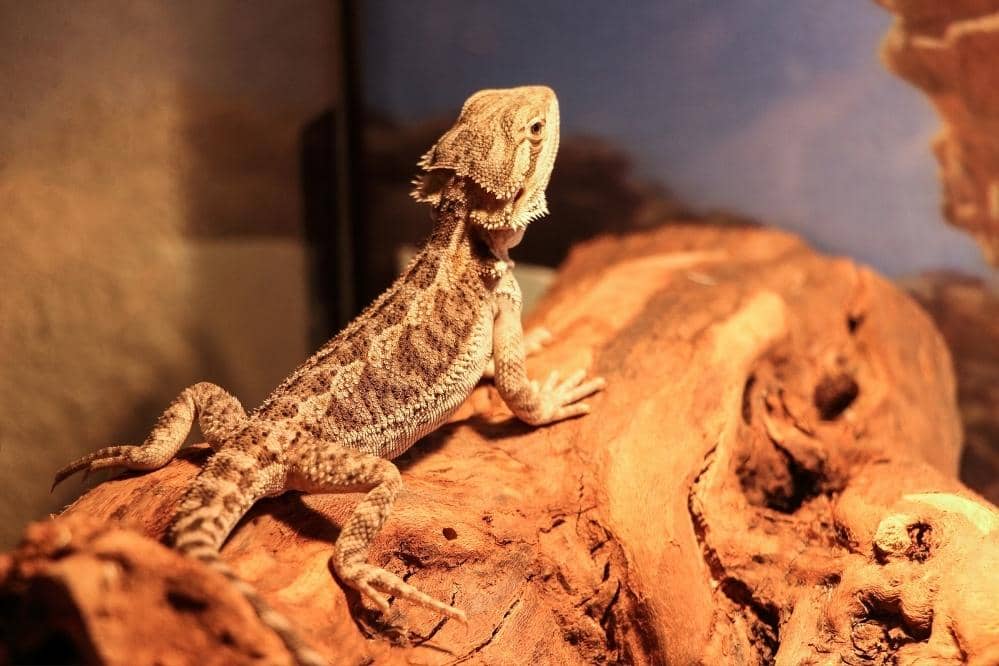Owning a Bearded dragon as a pet is a bit different experience than owning a dog or cat because dogs and cats can survive in the same environment we live in, and very few adjustments are required regarding housing and environment control. While bearded dragons live in a small enclosure, so you need to make special arrangements to provide them with enough light, establish a day-night cycle by controlling light timing, and most importantly, provide them sufficient heat and maintain the temperature within the recommended range.
So in this post, we have focused on the heat requirements of bearded dragons and will try to answer all your queries regarding this topic.
How Many Hours Of Heat Do Bearded Dragons Need?
As bearded dragons belong to hot Australian deserts, so they have evolved to require a lot of heat, and their bodies are built to work at higher temperatures. In addition, bearded dragons are cold-blooded or exothermic animals, which mean their bodies can’t produce enough heat to maintain their body temperature, so they always need heat from external source.
So we can conclude that bearded dragons need continuous heat supply 24/7. However, there is a slight variation in the temperature required during the day and night. They also require a comparatively cooler spot in the enclosure where they can cool down if they feel more heat.
Why Do Bearded Dragons Need Heat?
As mentioned above, bearded dragons can’t produce heat and rely on external heat sources, so continuous heat supply is vital to maintain their body’s temperature within the recommended range. It is necessary because heat is required to digest the food. If your beardie is not getting enough opportunity to bask or the temperature inside the enclosure is too low, the digestion slows down, and it can lead to impaction, which is really a painful condition. In addition, if undigested food stays in the gut for long, it can rot and produce many complex digestive issues.
Heat is also required to absorb nutrients, especially calcium, into the body. If your beardie is not getting enough warmth, calcium absorption will stop, leading to many issues related to calcium deficiency like metabolic bone disease and swollen joints.
In the wild, bearded dragons usually brumate (hibernation in the reptile world) in winter, so if the temperature inside the enclosure falls below a certain level, beardies may take it as a signal to brumate. Brumating once a year (or once in two years) is natural; however, brumating too often (more than once a year) can create a lot of health problems.
Temperature Requirements Of Bearded Dragon
| Age Group | Basking Temperature | Cool Area Temperature |
| Baby Bearded Dragons (Up to 5 months) | 95°F (35°C) to 110°F (43°C) | 80°F (26°C) to 90°F (32°C) |
| Juvenile Bearded Dragons (6 to 18 months) | 95°F (35°C) to 100°F (40°C) | 75°F (24°C) to 85°F (29°C) |
| Adult Bearded Dragons (Above 18 months) | 90°F (32°C) to 93°F (33°C) | 75°F (24°C) to 85°F (29°C) |
Temperature requirements for bearded dragons during different stages of life are shown in the table. However, many novice bearded owners may be confused about why two different temperatures (basking and cool) are given. Basking temperature is the hottest point, where bearded dragons usually spend most of their time absorbing heat. This point is generally just below the heat bulb or basking lamp. While the cooler area is the spot where the temperature is relatively lower than the basking area, and generally, this spot is at the opposite end of the heat source.
Why It’s Crucial To Maintain A Temperature Gradient Inside Enclosure ?
Although the bearded dragons are made to survive high temperatures and need a continuous heat source to fulfill their heat requirements, even then, when they feel overheated, they need a cooler spot where they can hide or stay for some time to cool down. Therefore maintaining a continuous temperature gradient inside the enclosure is necessary, with a basking point (hottest spot) in the center or at one end and a cooler place at the opposite edge of the chamber. This will help your beardie to move from one area to another to maintain his body temperature, as per his body’s requirements.
Do Bearded Dragons Need Heat At Night? / How Much Heat Do Bearded Dragons Need At Night?
Naturally, in all areas of the world, nights are cooler than days; however, the temperature change is more dramatic in some areas of the world. So the answer to the first question is “YES” bearded dragons definitely need a certain level of heat during the night, too, for the same reasons stated above.
Now, how much temperature should you maintain at night inside your beardie’s enclosure? It depends on the local environmental conditions and the temperature inside the room where the enclosure is placed. Bearded dragons generally need 65 °F – 75 °F (18 °C – 24 °C) during the night, so if the room temperature is around 70 °F, you don’t need any additional heat source for your beardie. However, if the room temperature falls below 65 °F, you need to provide an additional heat source. It is recommended to use heat sources that produce heat without producing light (e.g., ceramic heat emitter) to avoid disturbing their sleep and circadian rhythm.
Can Bearded Dragons Survive Without Heat?
No, as mentioned above, all reptiles (including bearded dragons) are cold-blooded animals and can’t maintain their body temperate on their own. This means they always need heat from some external heat source to keep their bodies functioning. Their bodies begin to slow down as the temperature decreases below the ambient level. They will not be able to walk or hunt properly and digest food, leading to many health issues. Adding to the misery, low temperature can induce brumation, and it is possible that your beardies may continue to sleep (without awakening) until the enclosure temperature rises.
How Long Can Bearded Dragons Survive Without Heat?
Most reptile experts believe that bearded dragons can survive for a maximum of 24 hours without a heat source. However, this statement does not mean they are perfectly OK for 24 hours. Bearded dragons will be OK for just a few hours in the absence of a heat source. After that, their ability to move and hunt will begin to be affected. Up to 24 hours, they will recover quickly as soon as the heat source is available and the temperature rises to the desired level. However, after 24 hours (depending on how much temperature fell when the heat source was unavailable), they may recover very slowly or not recover at all.
Minimum Temperature Bearded Dragon Can Withstand / Survive
Your bearded friend will be OK up to 65 °F, but they will not be as active as they should be. However, bearded dragons can withstand as low temperatures as 55 °F for 1-2 days. But they will not be active and will not eat and poop, so they can develop medical complications that require immediate veterinary medical care.
Wrapping Up
The take-home message is that providing an external heat source is vital for a bearded dragon. You must ensure that the temperature inside the enclosure is within the recommended range. You must also remember that your bearded friend can’t survive more than 24 hours at a temperature without a heat source. So always keep backup to be used in case of an unexpected power cut or your lamp burns out.

